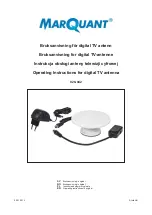
If the video seems to zip off the screen as soon as you stop on the channel try
changing the receiver’s polarization format. That is, if you have your odd
channels set for vertical polarization and your events for horizontal, change the
format to odds-horizontal, evens-vertical. You may not even know the present
polarization format changes the relationship of the feedhorn’s pick-up probe by
90 degrees. If changing the format keeps the video on the screen, then it has
to be the correct setting for that satellite on your system.
Select the best skew setting for the odd and even channels. The skew is the
fine tuning of the feedhorn’s polarization, required because the satellite’s
signal polarization is only truly “horizontal” or “vertical” when the satellite is
positioned at the same longitude as the installation site. The skew and format
buttons are found either on the front of the receiver or on the remote control.
Many receivers with on-screen graphics require you to choose these functions
on the menu.
Most receivers have a LED signal level indicator on the front panel or a digital
level indicator presented by on-screen graphics. The level indicator provides a
better reading of peak satellite performance in contrast to just viewing the
picture on the TV screen.
4) For locating satellite in the lower section of the Clarke Orbit, push the dish
right and left on the pole and move the drive east and west in slight
increments until you are satisfied you have the strongest signal. Then
tighten the mount’s bolt onto the pole so that the dish won’t rotate. Do not
tighten them down firmly yet, however. Note the numerical reading provided
on the receiver’s front panel or on-screen display that corresponds to dish
position at this location. This is a relative number that changes as the dish
moves.
5) Move the dish east or west until you reach the zenith for your location.
Select an active transponder for the satellite closest to the east or west of
arc zenith or turn the scan control on. Now move the dish in the direction of
the nearest satellite. If all the settings have been done right you should not
have a problem finding it.
6) For locating satellites that are in the upper section of the Clarke Orbit, jog
the actuator drive east and west and adjust the elevation bracket up and
down slightly. You should not have to move the elevation setting very much
because you already have pre-set it for your location. The rule of thumb
here is :
Rotate the dish on the pole and use the actuator to receive lower
satellites, but do not rotate the dish on the pole to receive upper satellites.
Adjust the elevation of the dish and use the actuator to receive upper






























